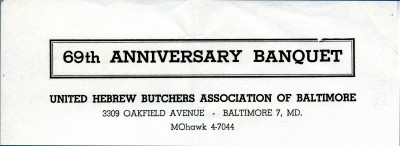Processions, Debates and Curbstone Encounters Part IV

Article by Avi Y. Decter. Originally published in Generations 2011 – 2012: Jewish Foodways.
The boycott of 1910 was one dramatic episode in a twenty-year struggle over kosher meat that engaged meat wholesalers, retail butchers, shochets (ritual slaughterers), the Orthodox rabbinate, and thousands of ordinary Jews, especially in East Baltimore. In the first decades of the twentieth century, conflict over kosher meat was a familiar topic. Today, that contestation is little remembered and poorly documented. However, sufficient evidence survives to give us access to the trajectory and meaning of the protracted struggle over kosher meat. Here is that story.
Part IV: Another Controversy over Kosher Meat
Missed the beginning? Start here.

The multi-sided conflict over kosher meat in spring 1907 was followed by an even more serious struggle two years later. This time the retail kosher butchers were pitted against the Orthodox rabbinate. Members of the Hebrew Butchers Association, composed of retail butchers and storekeepers, had begun to sell kosher meat shipped from Chicago. The rabbis issued a circular advising Orthodox Jews not to buy this Western meat on the grounds that kosher meat from Chicago was more than three days old by the time it reached consumers in Baltimore, rendering the meat treyfe (unfit).[1]
The retail butchers protested that the local rabbis were “exerting their influence to aid the local wholesale sellers” and that “the local meat trust” had substantially raised prices over the past two years, causing suffering by both the butchers and their customers. As a remedy, the kosher butchers had purchased lower-priced dressed meat from Chicago – a measure that affected the income of local shochets (who, the butchers alleged, had complained to the rabbis.”)[2]
In June the conflict flared anew. The Hebrew Butchers Association again accused the Orthodox rabbis and the shochets of combining with the wholesalers, asserting that the “trust” would make the price of kosher meat “pretty hard for the consumers.” For their part, the rabbis contended that the butchers were objecting “as a lame excuse against the system of inspection” the rabbis intended to institute.[3] Moreover, the rabbis threatened, if the butchers did not submit to rabbinic inspection, the Orthodox congregations would open “independent butcher shops” under their supervision.[4]
In the event, the Federation of Orthodox Hebrew Congregations concluded an agreement with the wholesalers that kosher meat would be priced at no more than one cent a pound more than non-kosher meat and that a system of rabbinic inspection would be paid for directly by the retailers in proportion to their sales. The retailers’ group, the Hebrew Butchers Association, immediately rejected the Federation’s solution as an imposition, announcing that their members would purchase Western beef from Chicago and create a rival system of inspection. The conflict caused division among the butchers, with twenty butchers acceding immediately to the Federation and the majority following suit with a few months. By September 1909 only thirty-five out of more than 100 kosher butchers continued to resist the Federation’s authority.[5]
Continue to Part V: The Community Responds
Notes:
[1] “Fight Over Kosher Meat,” Baltimore Sun, 19 April 1909, p. 9.
[2] “Fight Over Kosher Meat.”
[3] “At Odds Over Kosher Meat,” Baltimore Sun, 14 June 1909, p. 9.
[4] “May Settle Kosher War,” Baltimore Sun, 16 June 1909, p. 7.
[5] “To Hear Kosher Butchers,” Baltimore Sun, 18 June 1909. “Rival Kosher System,” Baltimore Sun, 28 June 1909, p. 14. “Kosher Meat Causes Split,” Baltimore Sun, 6 September 1909, p. 12.
